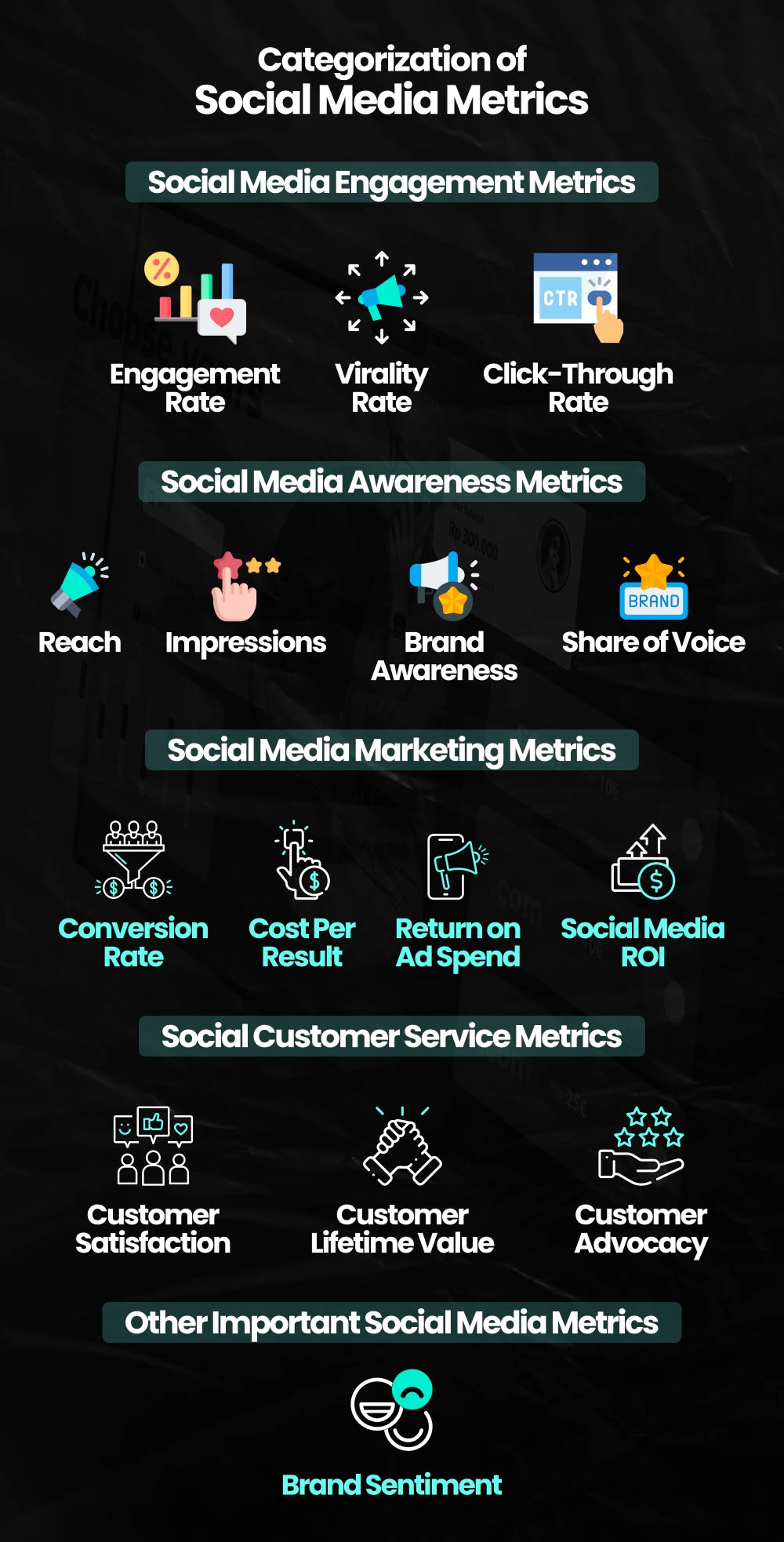15 Social Media Metrics to Track in 2024
In the fast-paced world of social media, where over 4.9 billion people regularly engage, standing out is difficult. With customers switching between six to seven platforms each month, how can you ensure your message is heard in this digital noise? The solution is not to shout louder, but rather to listen more carefully. How do you do this? By utilizing the power of social media metrics.
These metrics are more than just numbers; they’re insights into your audience’s behavior, the effectiveness of your content, and the overall health of your social media strategy.
By understanding and tracking the right metrics, you can:
Know your audience
Measure success
Optimize your campaigns
Stay ahead of the crowd
Now let’s review the 15 social media metrics you need to understand, measure, and pay attention to.
What are Social Media Metrics and Their Importance?
Social media metrics are numerical data and statistics that shed light on the success of your social media marketing efforts. They offer comprehensive insights into your campaign’s performance – from the engagement rate to the growth of your audience, from the conversion rate to the cost of acquiring a customer, and beyond.
By monitoring Social Media Metrics, you can pinpoint what’s effective, what’s falling short, and where to allocate your resources for optimal results.
Categorization of Social Media Metrics

Social Media Engagement Metrics
These metrics refer to the quantifiable measures that assess how actively and effectively users interact with your content on social media platforms. These metrics include likes, shares, comments, retweets, and clicks, providing insights into audience engagement, brand reach, and the impact of your social media efforts.
1. Engagement Rate
What is Social Media Engagement Rate?
It is the percentage of people who interact with your content, such as likes, comments, shares, or saved images or videos. Engagement rate is one of the most important social media metrics, as it shows how much your audience is interested in and involved with your brand.
How to Measure Social Media Engagement Rate?
There are different ways to calculate the engagement rate, depending on the platform and the type of content. However, a common formula is:
Engagement Rate = (Total engagements / Total reach or impressions) x 100%
For example, if your post received 100 likes, 20 comments, and 10 shares, and reached 1,000 people, your engagement rate would be:
Engagement Rate = (100 + 20 + 10) / 1,000 x 100% = 13%
How to Improve Social Media Engagement Rate?
To improve your engagement rate,
- Ask open-ended questions, host polls or contests, and respond to comments promptly to foster interaction.
- Analyze peak engagement times for your audience and post consistently during those periods.
- Experiment with different formats (videos, images, stories) and cater to your audience’s interests.
2. Click-Through Rate
What is Social Media Click-Through Rate?
CTR is a performance metric that measures the proportion of clicks an advertisement or a link receives on a social media platform relative to the number of impressions it gets.
This metric is crucial in social media marketing campaigns as it provides insights into the effectiveness of the content or ad in engaging users. It is commonly used in evaluating the performance of social media ads, links embedded in posts, and call-to-action buttons.
How to Measure Social Media Click-Through Rate?
Social Media Click-Through Rate can be calculated differently depending on the platform and the type of content or ads. However, a common formula is:
CTR = (Total Clicks / Total Impressions) x 100%
For example, if your post received 1,000 impressions and 100 clicks, your CTR would be:
CTR = (100 / 1,000) x 100% = 10%
How to Improve Social Media CTR?
To improve your Social Media Click-Through Rate
- Avoid generic CTAs like “click here”. Highlight benefits, e.g., “Claim your free gift now!”.
- Highlight the value users will gain by clicking through in your descriptions.
- Ensure the linked landing page is relevant and offers a seamless user experience.
- If your ads have visuals, consider changing colors, images, etc. for better engagement.
3. Virality Rate
What is the Social Media Virality Rate?
It is a metric that measures the ratio of shares a post receives about its unique views. It serves as an indicator of the speed and reaches of your content’s dissemination on social media platforms.
How to Measure Social Media Virality Rate?
Social Media Virality rate can be measured by using the following formula:
Virality Rate = (Total Shares / Total Impressions) x 100%
For example, if your post received 10,000 unique views and 1,000 shares, your virality rate would be:
Virality Rate = (1,000 / 10,000) x 100% = 10%
How to Improve Social Media Virality Rate?
To improve your virality rate,
- Stimulate strong emotions like humor, surprise, or curiosity in your content to increase shareability.
- Incorporate relevant trending topics and hashtags to ride the wave of online attention.
- Incentivize sharing by offering prizes for user-generated content or referrals.
Social Media Awareness Metrics
These metrics reflect your existing and potential audience. They indicate the attention your brand gets across all social media platforms per reporting period, including impressions, shares, mentions, and links.
4. Reach
What is Social Media Reach?
Reach is the number of unique people who saw your content or ads on social media. Reach is an important social media metric, as it shows how far your brand message is spreading and how many potential customers you are reaching.
How to Measure Social Media Reach?
Reach can be calculated differently depending on the platform and the type of content or ads. However, a common formula is:
Reach = Total Impressions / Frequency
For example, if your post received 10,000 impressions and was seen by each person twice on average, your reach would be:
Reach = 10,000 / 2 = 5,000
How to Improve Social Media Reach?
To improve your reach, you should:
- Research and incorporate trending hashtags to increase discoverability.
- Target specific demographics and interests to expand your reach beyond organic followers.
- Partner with relevant creators to leverage their established audience.
5. Impressions
What are Social Media Impressions?
Impressions are the number of times your content or ads were displayed on social media, regardless of whether they were clicked or not. They are an important social media metric, as they show how much exposure and awareness your brand is generating and how many opportunities you have to reach your audience.
How to Measure Social Media Impressions?
Impressions can be calculated differently depending on the platform and the type of content or ads. However, a common formula is:
Impressions = Reach x Frequency
For example, if your post reached 5,000 people and was seen by each person twice on average, your impressions would be:
Impressions = 5,000 x 2 = 10,000
How to Improve Social Media Impressions?
To improve your impressions, you should:
- Use eye-catching images and videos to grab attention and increase visibility.
- Craft captivating titles and summaries to pique interest and encourage clicks.
- Utilize platform-specific features like story highlights or pinned posts to keep content visible.
6. Brand Awareness
What is Social Media Brand Awareness?
It refers to the extent to which people are familiar with a brand and its identity through its presence on social media platforms. It goes beyond simply remembering the brand name; it encompasses recognition of the brand’s voice, values, and offerings within the social media landscape.
Suggested Post: How to Build An Impactful Social Media Presence for Your Brand
How to Measure Social Media Brand Awareness?
Brand awareness can be measured by using various methods and indicators,
Brand Recall: This is the ability of your audience to spontaneously remember your brand name when prompted by a category or a keyword.
For example, if someone asks you to name a soft drink brand, and you say “Coca-Cola”, that means you have a high brand recall for Coca-Cola.

You can measure brand recall by conducting surveys, polls, or quizzes on social media or other platforms, and asking your audience to name the first brand that comes to their mind for a given category or keyword.
Brand Recognition: This is the ability of your audience to identify your brand name, logo, products, or services when they see or hear them.
For example, if you see a golden arch and immediately think of McDonald’s, that means you have a high brand recognition for McDonald’s.

You can measure brand recognition by using tools such as Google Trends or BuzzSumo to monitor the search volume and social media mentions of your brand name, logo, products, or services over time and across different platforms.
Brand Associations: This is the set of attributes, emotions, or benefits that your audience links to your brand name, logo, products, or services.
For example, if you associate Nike with sports, performance, and inspiration, that means you have strong brand associations with Nike.

You can measure brand associations by using tools such as Hootsuite Insights Powered by Brandwatch or Mentionlytics to analyze the sentiment, topics, keywords, hashtags, or influencers that are related to your brand name, logo, products, or services on social media.
How to Improve Social Media Brand Awareness?
To improve your brand awareness,
- Select social media platforms that best align with your brand’s identity and target audience.
- Regularly post high-quality, authentic content that resonates with your audience. Use scheduling tools to maintain consistency.
- Foster an emotional connection with your audience by initiating conversations, asking questions, and responding to their interactions.
7. Share of Voice
What is Social Media Share of Voice?
Social Media Share of Voice (SOV) is like your brand’s loudness on social media. It measures the percentage of online conversations about your industry or topic that mention your brand, compared to competitors. Think of it as owning a slice of the online chatter.
Suggested Read: Major Things to Consider in Brand Building
How to Measure Social Media Share of Voice?
Share of voice can be measured by using various methods and indicators, such as
- Use tools like Brand24 or Hootsuite to monitor your brand and competitor mentions on major platforms.
- Divide your brand mentions by the total industry mentions within your defined timeframe.
- See if the mentions are positive, negative, or neutral to understand brand perception.
How to Improve Social Media Share of Voice?
To improve your Social Media Share of Voice,
- Create an appealing storyline that shows your brand’s basic values, mission, and unique features. This story must connect with the people you are targeting and impact their views around your brand.
- Perform market research to find out about your target audience’s interests, behaviors, and buying patterns. Use this information to create detailed buyer personas and adjust your social media content and engagement methods.
- Maintain uniformity in the way you communicate and offer authentic stories and experiences that indicate your brand’s identity.
Social Media Marketing Metrics
These metrics are data points that measure how well your social media strategy is performing. They reveal how much effort and money you’re spending, and how much you’re getting in return. This includes tracking metrics like engagement rates, click-throughs, and reach.
8. Conversion Rate
What is Social Media Conversion Rate?
Conversion rate is the percentage of people who complete a desired action on your website or landing page after clicking on your content or ads on social media. A desired action can be anything you want your audience to do, such as signing up, subscribing, downloading, purchasing, or contacting.
It is an important social media metric, as it shows how effective your content or ads are at generating leads, sales, or revenue for your business. It also affects your return on investment (ROI), which is the ratio of your profit to your cost.
How to Measure Social Media Conversion Rate?
Conversion rate can be calculated differently depending on the platform and the type of content or ads. However, a common formula is:
Conversion Rate = (Total Conversions / Total Clicks) x 100%
For example, if your post received 100 clicks and 10 conversions, your conversion rate would be:
Conversion Rate = (10 / 100) x 100% = 10%
How to Improve Social Media Conversion Rate?
To improve your Social Media Conversion Rate,
- Tailor messaging and promotions to specific audience segments and their needs.
- Streamline checkout procedures and offer multiple payment options.
- Identify areas where users drop off and optimize the conversion funnel.
9. Cost Per Result
What is Social Media Cost Per Result (CPR)?
It is the average cost of achieving a specific result from your social media ads. A result can be anything that you set as your campaign objective, such as impressions, clicks, conversions, leads, or sales.
Cost per result is an important social media metric, as it shows how efficiently you are spending your ad budget and how well you are optimizing your campaigns.
How to Measure Social Media Cost Per Result (CPR)?
Cost per result is calculated by dividing your total ad spend by the total number of results.
Cost Per Result = Total ad spend/ Total number of results
For example, if you spent $1,000 on your social media ads and generated 500 leads, your cost per result would be
Cost Per Result = $1,000 / 500 = $2
How to Improve Social Media Cost Per Result (CPR)?
To improve your cost per result, you should:
- Tighten your ad targeting parameters to reach the most relevant and likely converting audience.
- Perform A/B testing for different ad formats, visuals, and copy to find the best-performing combination.
- Regularly monitor your bids to ensure you’re competitive while staying within budget.
10. Return on Ad Spend
What is Social Media ROAS?
Return on Ad Spend is the ratio of revenue generated by your social media ads to the cost of your ad spend. ROAS is an important social media metric, as it shows how profitable your social media advertising is and how much return you are getting for every dollar you spend.
Must Read: What Is Social Media Advertising and Why Is It Important for Your Brand?
How to Measure Social Media ROAS?
ROAS is calculated by dividing your total revenue by your total ad spend.
Return on Ad Spend = Total Revenue/ Total Ad Spend
For example, if you spent $1,000 on your social media ads and generated $5,000 in sales, your ROAS would be:
ROAS = $5,000 / $1,000 = 5
This means that for every $1 you spend on your social media ads, you get $5 in return.
How to Improve Social Media ROAS?
To improve your ROAS,
- Refine your keywords regularly. This ensures that your advertisements reach the right viewers, increasing the likelihood of conversion.
- Use a data-driven approach to create and optimize advertisements. Analyzing data helps determine what works best for those you want to reach, which leads to more effective ad campaigns and higher ROAS.
- Think about broadening your audience for better ad scalability and ROAS. Reaching out to more people increases the possibility of more conversions, which improves your ROAS.
11. Social Media ROI
What is Social Media Return On Investment?
Social Media Return On Investment (ROI) is essentially your scorecard for social media efforts. It measures the value you get from your social media activities compared to the resources you invest. Think of it as the financial performance of your social media game.
How to Measure Social Media ROI?
Social Media ROI can be measured using the following formula:
Social Media ROI = (Net Profit / Total Investment) x 100%
For example, if your social media campaign costs $1000 and it brought in $5000 in revenue, your Social Media ROI would be:
Social Media ROI = (($5000 – $1000) / $1000) x 100% = 400%
How to Improve Social Media ROI?
To improve your Social Media ROI,
- Decide what you want to achieve with your social media marketing, such as growing brand awareness or sales.
- Keep an eye on how your social media activities are performing. This includes likes, shares, comments, and, especially conversions.
- If something isn’t working properly, modify it. Use the knowledge you’ve obtained to improve your social media marketing. This could involve posting at different times, experimenting with new sorts of content, or focusing on a different audience.
Social Media Customer Service Metrics
These metrics are data points that help you understand how effective your efforts are in satisfying your customers. They uncover what your social customer care team is doing well, where there are opportunities to improve, and what tools are needed to fill those gaps.
Also Read: 7 Tips to Convince Your Customers to Buy From You.
12. Customer Satisfaction
What is Social Media Customer Satisfaction?
Customer Satisfaction is the measure of how products or services provided by a company meet or surpass customer expectations. It is a key performance indicator within business and is part of the four perspectives of a Balanced Scorecard.
How to Measure Social Media Customer Satisfaction?
Customer Satisfaction can be measured using the following formula:
Customer Satisfaction Score (CSAT) = (Number of satisfied customers / Number of survey responses) x 100%
For example, if you received 200 responses to your satisfaction survey and 180 customers indicated they were satisfied, your CSAT would be:
CSAT = (180 / 200) x 100% = 90%
How to Improve Social Media Customer Satisfaction?
To improve your Customer Satisfaction,
- Acknowledge and address both positive and negative feedback promptly and respectfully.
- Analyze social media conversations to identify areas for improvement in customer experience.
- Regularly gather feedback through surveys or polls to understand customer sentiment and pain points.
13. Customer Lifetime Value
What is Social Media Customer Lifetime Value?
Customer Lifetime Value is the measure of the total net profit that a company makes from any given customer. CLV is a vital metric as it helps businesses determine the economic value of a customer relationship, based on the present value of the projected future cash flows from the customer relationship.
According to Forbes, “Businesses have a 60% to 70% chance of selling to an existing customer, while for a new prospect, it’s just 5% to 20%.”
How to Measure Social Media Customer Lifetime Value?
Customer Lifetime Value can be measured using the following formula:
Customer Lifetime Value = (Average Purchase Value / (1 – Retention Rate)) – Customer Acquisition Cost
For example, if your average purchase value is $100, your retention rate is 0.5, and your customer acquisition cost is $20, your CLV would be:
Customer Lifetime Value = ($100 / (1 – 0.5)) – $20 = $180
How to Improve Social Media Customer Lifetime Value?
To improve your Customer Lifetime Value,
- Interact with your customers in person. Respond to their comments, like their posts, and indicate that you respect their feedback.
- Offer exclusive deals and discounts to your repeat buyers. This not only motivates people to buy again, but also to tell others about your brand.
- Use what you know about your customers to create content that interacts with them. If you have distinct categories of customers, try to develop separate types of content for each of them.
14. Customer Advocacy
What is Social Media Customer Advocacy?
Customer Advocacy is the measure of customers’ willingness to actively promote the products or services of a company. It is a powerful form of marketing as it leverages the trust and relationships that customers have within their own networks. It can lead to increased brand awareness, credibility, and ultimately revenue.
How to Measure Social Media Customer Advocacy?
Customer Advocacy can be measured using the following formula:
Net Promoter Score (NPS) = % of Promoters – % of Detractors
For example, if 70% of your customers are promoters (score 9-10) and 10% are detractors (score 0-6), your NPS would be:
Net Promoter Score = 70% – 10% = 60%
How to Improve Social Media Customer Advocacy?
To improve your Customer Advocacy,
- Regularly engage with your followers and customers on social media. Respond to their comments, address their questions, and express gratitude for their feedback.
- Motivate your buyers to share their brand experiences and showcase their content on your social media platforms. This helps people feel valuable and encourages advocacy.
- Create a community around your brand where people can connect, exchange experiences, and sense a feeling of participation. This encourages loyalty and advocacy.
Other Important Social Media Metrics
These could include a variety of metrics depending on your business goals. They might include measures of activity, reach, acquisition, conversion, retention, and advocacy. They help you determine how well your campaigns and strategies are performing
15. Brand Sentiment
What is Social Media Brand Sentiment?
It is the measure of how your brand is perceived by the public. It reflects the feelings and attitudes people hold towards your brand, products, or services. Brand sentiment is a crucial metric as it can influence your brand reputation, customer loyalty, and ultimately, your bottom line.
How to Measure Social Media Brand Sentiment?
Brand Sentiment can be measured using social listening tools that analyze the tone and emotion behind words used in mentions of your brand on social media and other online platforms.
For example, if your brand received 500 mentions in a month, and 400 of them were positive, your positive brand sentiment would be:
Positive Brand Sentiment = (400 / 500) x 100% = 80%
How to Improve Social Media Brand Sentiment?
To improve your Brand Sentiment,
- Utilize social listening tools to track and analyze mentions of your brand.
- Address negative feedback promptly and professionally to mitigate its impact.
- Implement strategies to incentivize positive reviews and showcase them prominently.
Final Thoughts
In wrapping up, understanding and monitoring social media metrics is a key aspect of digital marketing in 2024. All the metrics mentioned above offer a window into the effectiveness of your content and the behavior of your audience. They enable you to identify successful strategies, areas for improvement, and the best allocation of resources for maximum results.
However, keeping up with these metrics and interpreting them can be a daunting task if you’re not well-versed in the field.
This is where Mastroke, a digital marketing agency, comes into play.
Mastroke can take on the task of tracking, analyzing, and interpreting these metrics for you. With their expertise, you can gain actionable insights to fine-tune your social media strategy and achieve your business objectives. So, while you focus on your core business, Mastroke ensures that your social media presence is optimized and effective.

